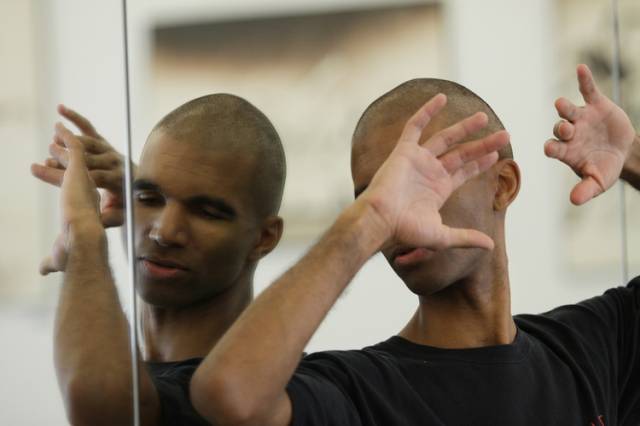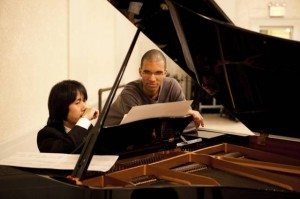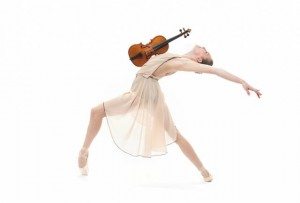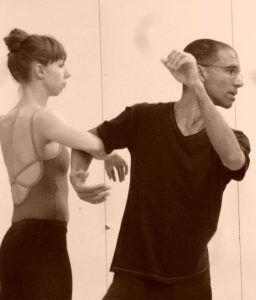

When I spoke last week with Miro Magloire, a composer-turned-choreographer and the founder/artistic director of New Chamber Ballet, I loved hearing him refer to works of art as "things." For Magloire, his art is not overly precious, nor is it casual. He carefully and intelligently combines music and movement using only piano, violin, and a few dancers, letting the art speak for itself without conventional theatrical elements, and using only what is necessary. What matters is the the need to create, his dancers' well being, and the audience's experience.
The company has two new pieces that will premiere this weekend: a duet choreographed by Magloire to a piano piece by French composer Tristan Murail, and a new ballet by resident choreographer Constantine Baecher. After speaking with Miro about dance, music, and his choreographic process, I'm ready for another fulfilling experience with the New Chamber Ballet.
You've said that you like to start with a choreographic question. Is that always where you begin, or do you ever get your choreographic ideas from a piece of music?
I see choreography in music a lot, but I never use that for my pieces because I think that it would come out terribly cliché. For instance, I hear a piece of music and see exactly what you’d think would happen with the music, and people would just roll their eyes. I have a whole, constant interaction with music and with other composers both living and dead. Especially living composers, but I actually keep going back to the generation of composers who were the big idols when I was young. Most of them are dead now but started to work after World War II and the second half of the twentieth century into the beginning of this century and also composers of the next generations. So, I try to get deep into the music because that music is so different and, at the same time, I think that it is so good that I keep revisiting it, and I keep listening to it — I have piles of pieces. New Chamber Ballet is all piano and violin, so already that is a sub-pile. That pile, I keep revisiting and keep going back to, listening to this or that just to get deeper into the piece. That has nothing to do with any specific choreographic idea, just getting to know that music better, and at some point I feel that I really have the piece, but that still doesn't mean I’m going to choreograph it. It’s more of a practical decision. At the same time, I work on these choreographic problems and nowadays on visual art. I’m trying to train myself to see better…to have stronger eyes and a stronger eye/brain connection.
What do you mean by that?
If I look over there, what do I see? I see the volume of the table, I see how it gives a certain weight to this part of the room. We have these strong, straight lines across the room, and then it's echoed over there, et cetera. I'm trying to become aware of visual structures in terms of line and volume so when I go into the studio, I can build things around that -- except these dancers are moving things. Somehow they have to do with dance steps, training, or at least with physical properties of the human body.

At some point, this connects to something that was in one of these piles. The original matching of the movement of a particular piece and a particular piece of music often times happens with a lot of randomness in it, because there are so many options here and there, and an awful lot of circumstance. Once they are matched, they have to learn to live together. From that moment on, everything I do is very much targeted to the music in its character and to its overall shape.
There's a lot of talk about collaboration -- you can get funding, grants, commissions for the creative process of working together with a composer -- and I always find that I can't say that I feel more in tune with the music if I sit with the composer. I feel like I'm the most in tune with the music when I've lived with it, listening to it for many years. I don't care about the composer; I care about the music.
Is that because you can connect it with certain experiences, or senses perhaps?
I think it's because I just get to know the piece better. When I work with a composer, they can tell me how it is written, but that's not the piece. The piece is something that happens when you listen to it over and over and over. By the time I choreographed a piece, let's say I've spent two months listening to the music in rehearsal. If it's a ten minute piece, let's say we've run it two or three times plus gone over details, I've heard it four or five times and again the next day: that's twenty five times a week. Plus, when I go home, look at the video and work on it: that's another twenty five times a week. That's fifty times a week times eight, which is four hundred times. Find me any composer that listens to their work, once they're done composing it, four hundred times. I find that when I collaborate, I get to know much more about the composer, and much less about the piece of music. The piece of music is usually being written when I choreograph. I receive the score a month before, and by the time we have a recording it's a month before the showing. So, I just do my own thing. Conceptually, we agreed to do this or that, but the actual connection is much less intense than if I take a piece from someone. Even if it's someone from half a world away that's been dead for ten years, I still get a deeper connection because I connect to the music rather than to the composer.
I very welcome the fact that we get to work together and look forward to working with another composer. I love that kind of work. But the reality is that in order to have the same connection, I want to start the collaboration four years before the opening night. I've had that conversation with every composer I've worked with and they get it and agree to the problem. But, that's not how commissions work.
Your connection with the music is going to be very different from the audience’s because they only get one shot to listen to the music and view the movement. How do you communicate through the work with your audience given that understanding?
I have to make sure that they get enough of an in that they are willing to come see it again at some point. I suppose that what I try to do is create pieces that allow a kind of viewing for an audience where you can see them several times and discover new things and like them more or like them less.

What I respect in your work is that with the minimal aspect of production — no lighting, in a studio space — you are forced to focus explicitly on the movement and music.
This kind of presentation in the modern dance world is no big deal. It's been there since the sixties, but no one has really brought it into the ballet world. The standard way of viewing ballet is from a distance where the curtain goes up and you see the thing; the curtain closes, and you never see the thing again. To bring it from the there and into the here, to me is an important factor. When I grew up, the theater artists that I admired the most were the ones that put a special emphasis on this magic moment -- now it's an ordinary person and (snaps fingers) now it's not, (snaps fingers) and now it is again. The transformation between reality and magic and reality again happens right in front of you, and you see it. To me, that experience is very powerful, and it's really important to me that when you see our performance, you are always aware that these are real people like you and me. They're not special, they're not stars... they may do something extraordinary, and I aim for them to be as extraordinary as possible, but before and after they should be the same as the audience as possible. Even during the performance, you can hear them breathe, you can see them have reactions to things that happen, they sometimes make more sound than the musicians.
For someone who has seen a lot of dance, you have to ask yourself: is what I see as dance actually full of non-dance stuff? And, if all that stuff is taken away, do I still like dance? What is it about it that I love? Am I going to the ballet to see costumes, lights, a warm, cushy seat? Sometimes people don’t like it. Our first five years, every reviewer said it would be so much nicer with lights. This was exactly my point, to make people question themselves about that. And, of course, like everything, if you just keep doing it people will stop complaining…no one writes this in reviews nowadays. And, I'm not saying that lights are bad. I grew up in Germany in the '80s when the art of theatrical lighting was done with obsessive intensity, so I know light and I love light. I just chose for a variety of practical reasons to not make it part of my artistic world so far. You have to actually look at the dance and listen to the music. We take away the packaging and this is just the thing. We aren't saying this is a better way, but I think it's an important way to present dance and confront oneself with the fact that this is dance and everything else is dance plus.
As a choreographer, you really have to take your craft seriously, because, for instance, how do you end a piece? Think about the ending to every single ballet you see and count how many times the ending is either people running into the wings and/or the lights going out or curtain going down. If you don’t have these options, how do you make it clear to the audience that it is over? The third option is to make a tableau, but with three dancers a tableau is like... (laughs) So how do I end my dances? It’s a nightmare to figure it out, but then you realize that often times you don’t solve problems choreographically in a real theater but with help from the other elements. If something is a little weak in the middle of the piece, dim the lights or bring very harsh light from the sides. So, it’s revealing to be here. To me that is really healthy, because I have to realize, for instance, this is a bad ending and I can't hide it.

How many pieces total in your repertoire?
Last time I counted, ninety. We’re in our eleventh season celebrating our ten year anniversary, and last season we celebrated our tenth season, so we've milked the number ten for a while, and I’m happy to move on. But maybe I should look into the one hundredth ballet we’re doing or something…
Do you have a vision for where the company might be another ten years from now?
I have many visions, but I have found that I think what makes the company function is that I’ve always completely ignored the visions. Let me explain what I mean: one of my biggest idols growing up was John Cage. I came to New York to visit, and I met him and spent several afternoons with him. He was very clear about that instead of having a vision that’s out there, and you running around trying to somehow realize that, take a good look around you and see what you have right now, and do something with that.
That sounds exactly like something John Cage would say.
I’ve always felt that was the way I can work best. Rather than saying that ten years from now, I would love to have my own space, this kind of budget, et cetera, I’m looking around me. That’s how the company started. I had no board, no budget; I had no access to funding. Neither I nor any of my dancers had a name or had been in a big company. So we asked what we need to be happy. I said I need to create and the dancers said they need to preform. We needed a space with a dance floor and enough room to hold a few people for an audience. There it is -- that's New Chamber Ballet. For me now, I need to look better into the now and ask where has the reality changed, what now should be different. I think that is more important than a vision for the future. Should we be financially stronger? Is this normal, or are we missing something? Is it possible that we should be performing more or am I not realizing something? I think if we really pay attention to the now, we'll get to the future. None of what we do now has to do with what I thought ten years ago.
I’m not at all where I envisioned myself ten years ago, that’s for sure!
Having made this trajectory with maybe the smallest budget of any small New York City ballet company forced us, all of the artists, to be very judicious about the choices we've made. What’s necessary? What can we do without? Having come of age in Germany and starting my artistic career and professional life in the German system of heavy-league government-owned companies where you’re a public employee, where we live in an entirely different universe of financial means and possibilities, but also of bureaucratic necessities… I realized you can do first-class, quality work without being a part of this gigantic institutional world that has huge budgets and lot of money that can be spent and must be spent. No, you can leave all this out, but then you have to say no to almost everything and find the one thing that is necessary. We've done years of just piano and violin… I would love to use the cello, but it would make what we want to do years down the line an impossibility. Some people ask me what advice I would give to young choreographers, and what I say is: say 'no' a lot. Say 'no' to your own ideas a lot. Say 'no' to nine ideas until you find the tenth one that is the one you should actually be doing. Otherwise, ideas are like children in the car when you’re trying to drive somewhere. I feel like that living my life -- my ideas want me to stop here and there for coffee and chocolate and ice cream, and I'm like "nope."
You just have to keep driving... I understand, though that seems very hard to do.
I don’t find it so hard anymore. I enjoy it. It makes me realize how overestimated the importance of ideas is. Forget about the ideas, just take something and make something out of it, rather than waiting… you can make something out of anything and make something great out of it. Just keep chipping away until it's something beautiful.
New Chamber Ballet will perform at City Center Studios April 17-18 and June 12-13. For more information, visit the website: https://www.newchamberballet.com/
New Chamber Ballet performs April 17 and 18 at City Center Studios.